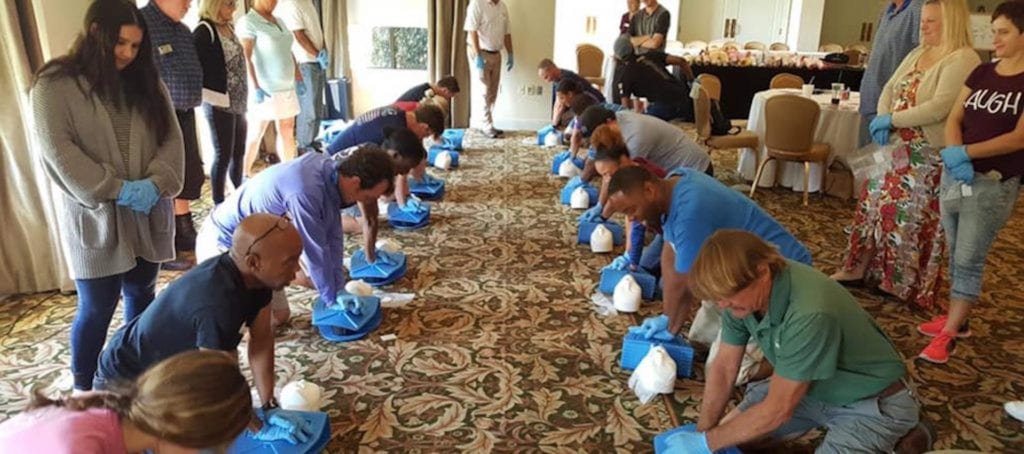
Prioritizing occupational safety and emphasizing how preventative actions can reduce risks and create a safer workplace environment is important for all organizations. While workplace safety programs typically focus on accident prevention, one often overlooked but critical skill in the workplace is cardiopulmonary resuscitation (CPR).
Investing in CPR training can reduce risks in the workplace by equipping employees with lifesaving skills for emergency situations — and that’s the kind of proactive measure every workplace should embrace.

Recent workplace injuries and fatalities
According to the most recent data from the U.S. Bureau of Labor Statistics (BLS), the United States reported approximately 2.6 million nonfatal workplace injuries and illnesses from private industry employers in 2023. Industries reporting the highest number of cases include:
- Health care and social assistance (562,500)
- Manufacturing (355,800)
- Retail trade (353,900)
- Transportation and warehousing (265,700)
- Accommodation and food services (231,400)
- Construction (173,200)
Additionally, private industries reported 5,283 fatal work injuries in 2023. The BLS reports the Census of Fatal Occupational Injuries (CFOI) found that one worker died every 99 minutes from a work-related injury.
These injury statistics underscore the critical need for having a prepared workforce in place. As part of comprehensive safety training, hands-on CPR, AED, and First Aid training with an instructor equips employees with the knowledge, skills, and practice necessary to respond immediately and effectively before professional medical help arrives.
The important role CPR and First Aid training plays in occupational safety

Having CPR-trained staff can make a significant difference in reducing injuries and increasing response times in medical emergencies. Here are just a few examples of how CPR training can reduce risks in the workplace and benefit your team overall:
1. CPR and First Aid training can help reduce workplace injuries
Workplace injuries can range from minor injuries to life-threatening emergencies, such as a heart attack or severe accident. For example, in high-risk industries (e.g., manufacturing and construction) workers are frequently exposed to heavy machinery and other potential hazards that can result in common injuries like electrical shock, severe bleeding, and cardiac events.
By providing CPR and First Aid training programs, employees are prepared to respond to a variety of emergencies, helping to reduce the severity of injuries and potentially saving lives.
Additionally, by practicing real-life scenarios during CPR class, it places workers in a preventative mindset that encourages vigilance and readiness.
2. CPR and First Aid training fosters a culture of proactive safety
Offering CPR training helps create a culture of proactive safety that prioritizes the health and well-being of employees. This approach encourages employees to take ownership of their own safety, as well as the safety of their coworkers and visitors. As a result, employees may be more likely to follow safety protocols, report potential hazards, and collaborate to avoid workplace accidents.
By actively engaging in workplace safety training, companies can help employees feel more confident in their ability to handle the unexpected — while also boosting employee morale, increasing job satisfaction, and strengthening their overall team mentality.
3. CPR certification helps meet regulatory requirements and industry standards
Many industries — particularly those with high-risk activities — are subject to certain legal requirements and oversight from government and industry regulatory bodies, such as the Occupational Safety and Health Administration (OSHA). These regulatory organizations often require or recommend CPR and First Aid training as part of a broader commitment to safety.
Investing in workplace CPR training can ensure employers stay in compliance with regulatory requirements and industry standards. You’ll need to carefully choose a CPR training program that is recognized by your industry.
HSI’s emergency care training programs and brands are accepted, approved, or recognized as an industry credential meeting the requirements of thousands of U.S. state regulatory agencies, occupational licensing boards, national associations, commissions, and councils in hundreds of occupations and professions.
Benefits of CPR training beyond the workplace
The benefits of CPR training in the workplace are clear, but its value extends far beyond the office, factory, or job site. In fact, employees who are trained in CPR are more likely to use their lifesaving skills in their personal lives, particularly at home, where medical emergencies can also occur unexpectedly. So, it’s important to communicate this to create more employee buy-in during training.
While CPR training might be a workplace requirement, it could be used to save a family member, friend, or even a stranger.
Take a proactive approach to workplace safety
The importance of workplace safety cannot be overstated. Whether it’s on a construction site, in a healthcare setting, or at a business office, having employees with CPR and First Aid certification training helps ensure your workplace is prepared to act decisively during emergency situations. Not only can full-certification CPR and First Aid training help reduce the severity of injuries, it helps promote a culture of safety that leads to fewer accidents, reduces liability risks, and improves employee morale.
Safety First can help your business with value-driven and flexible CPR, AED, and First Aid training. Contact us today.
Information by Health and Safety Institute.
